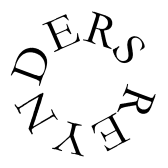

|
|
|
|
TIRIBAA rhythm of the Landumon(sp?) people of western coastal Guinea. There are three stages of history to Tiriba. First it was a mask dance and there was only one Tiriba in existance. He would go around and visit different villages after the harvest time with drummers to play and dance. When Tiriba died, the rhythm and dance lived on, and became a dance for the girls after their initiation. They would come together their mothers to honor them: "Thank you mother, now I know what I didn't know before, I am a woman now." Now Tiriba is a general dance of celebration played at all kinds of occasions, weddings, Ramadan, etc. The instumentation of Tiriba is somewhat different than the Malinke. There are no dunduns (sangban, kenkeni, or dununba.) Instead there is a single bass drum called a "drama" (sp?) It is a large one headed, open bottom drum with goat skin, that is played by hand, not with a stick. This drum is also used instead of dunduns by the peoples of western Guinea for rhythms Kakilambe, Sorseney, Yankadi/Macru. The jembe is also different, with antelope skin and a single large fan or kachink-kachink (Mamady did not give a name for the fan, just demonstrated with his hands) LYRICS: Kalum kaiyo Foriyae khili tikhi Gbasikolo konde bum Wo mamebe M'boree yo Kalum khili tikhi Gbasikolo konde bum + ... improvisation You the inhabitants of Kalum The elders appeal to everyone Below the kapocktree of Gbasikolo Have you heard my friends? Time 1 . . 2 . . 3 . . 4 . . 1 . . 2 . . 3 . . 4 . . | Break TtT t T t . T t . T |x x . x x . x x . x x . | Sangban |C . . O . . C . . O . . | |x x . x x . x x . x x . | Kenkeni |O O . C . . O O . C . . | |x x . x x . x x . x x . | Dununba |O . . . O . O . . . . . | Variation|. x x . x x . x x . x x | Dununba |O O . O . O . O . . . . | Accomp 1 |B s T . s . B s . B s . | Accomp 2 |B . . t S . B . . t S . | Accomp 3 |B . S b T t B s . b T t | TBD: Mamady showed a variation for Accomp 3 for playing at fast speeds, I will add this part whan I get the chance. NAME OF RHYTHM: Tiriba (Triba) COUNTRY: Guinea OTHER NAMES: REGIONAL/ETHNIC GROUPS: Baga (Sylla) Baga ethinc group, Coastal region, lower Guinea (Mamady Keita) Susu ethnic group, Boke region of lower Guinea (Blanc) Malinke, NW region of Guinea (Mattioli) PURPOSE/BACKGROUND: A rhythm of the Landouma people of western coastal Guinea. There are three stages of history to Tiriba. Tiriba was the name of a man. At first the rhythm was a mask dance. Tiriba would go around and visit different villages after the harvest time with drummers to play and dance. When Tiriba died, the rhythm and dance lived on and were named after him. Over time, the context of the dance has changed. Tiriba (the rhythm and dance) became a dance for girls after their initiation. Their mothers would organize a party and the young women would dance to show gratitude to their mothers and confirm that they were now women. They would come together with their mothers to honor them: "Thank you mother, now I know what I didn't know before, I am a woman now." Today, Tiriba is a general dance of celebration played at all kinds of occasions, weddings, Ramadan, etc. (Adam Rugo from Mamady Keita) Traditionally, there were no dunduns (sangban, kenkeni, or dununba) played on Tiriba. Instead there was a single bass drum called a "Drama". It is a large, one headed, open bottom drum with goat skin, that is played by hand, not with a stick. This drum is also used instead of dunduns by the peoples of western Guinea for rhythms like Kakilambe, Sorsenet, and Yankadi/Macru. (Doug Kane from Mamady Keita) Traditionally, the Tiriba is not played on the djembe but on smaller drums made of stretched deerskin with wooden corners. It is played for circumcisions and also during the medicine men's important festivals and ceremonies. (Blanc) ...a dance for young girls with their mothers after their initiation. (snip) Mamady did say that this rhythm has now become one that is played at all kinds of celebrations. (Bob Boyd) Tiriba is a Landuman people's rhythm (from W. Guinea). Traditionally danced by girls with their mothers after girls' initiation; indicates to the mothers that they know the "secrets" of womanhood. Popularly danced now in welcoming Ramadan, marriages, harvest ceremonies. (Pam Nishikawa from Mamady Keita) Rhythm of welcome of the Bagas, population of the costal region of Lower Guinea. (Mamady Keita) A welcome rhythm (Mattioli) A harvest dance of the Baga people (Abdoulaye Sylla) RELATED RHYTHMS: SONG LYRICS: Call: Kolipey watiley, banfa watiley Response: Eeh banfa watiley (The father is dancing with his young son, Kolipey) (Abdoulaye Sylla) Kalum kaiyo Foriyae khili tikhi Gbasikolo konde bum Wo mamebe M'boree yo Kalum khili tikhi Gbasikolo konde bum + ... improvisation You the inhabitants of Kalum The elders appeal to everyone Below the kapocktree of Gbasikolo Have you heard my friends? (Liner notes: Wassolon)
|